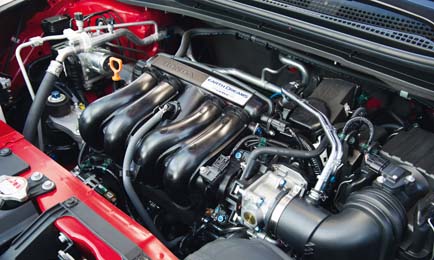When discussing the development of a new vehicle, the usual response from most automotive engineers are tales of restraint and constraint: we saved weight here, we minimised costs there.
But, sitting in a Lisbon hotel at its European launch, Yasuhiro Terada, Honda HR-V ALPL, and Hiroyuki Yamamoto, HR-V Interior Design PL, tell a different story about the development of the HR-V. “HR-V was a rare case. All the ideas and passion were allowed to be realised. There has been almost no compromise in terms of design. The engineers and designers were more free,” says Yamamoto.
The HR-V is a crossover sports utility vehicle (SUV) – a type of car growing massively in popularity around the world. Also known as a mini SUV or subcompact SUV, its key characteristic is that it is shorter than a regular SUV at under 4.2m long.
Honda claims to have invented the crossover SUV with the HR-V in 1999. The car was phased out of production, but since then cars such as Nissan's Qashqai have revitalised the market segment.
One in five cars sold in Europe was a crossover SUV during 2014, some 2.5 million cars. According to consultancy Frost and Sullivan, by 2022, 7.4 million mini SUVs will be sold globally. At least 46 different car manufacturers will make 84 different models.
The HR-V is therefore vitally important to the Japanese carmaker, which is keen not to miss out on the world's fastest growing car market. It's also a return to a market it abandoned almost a decade ago.
Yamamoto says: “We set out with the intention of wanting to rebuild the global standards for such cars. In Europe — a region steeped in history of car design — we wanted to create something that would be well-received and respected in terms of quality and performance.
“We did a lot of research in Europe, as well as China, the US, all around the world, about what customers expect from the car. We wanted to distill those requirements into a single vehicle and set a new standard.”
The results did not show as much variation in expectations as one would expect from different regions. So, the HR-V is designed with coupe stylings inside and out, a high seating position, dynamic performance and market leading space inside – to transport all the surfboards or houseplants you need.

The 1.5 direct injection engine has tumble injection ports to optimise air-fuel mix
The HR-V has also not been tweaked for different regions. Apart from different engine options and a different interior finish in Europe, it is identical to the US and Japanese versions. “There were no tweaks for different versions. We didn't adapt the car, the rules adapted to us,” says Terada.
The HR-V is based on Honda's global compact platform, which is used on all of the company's modern cars. This approach stretches beyond what many carmakers define as a platform and also covers many design elements and systems.
For example, the suspension across different cars that use the platform is the same, the centre tank layout, a patented Honda design that places the fuel tank under the front seats, is shared. However, the dimensions vary radically, and the wheelbase and tread are different.
This global commonality also acts to raise the quality of some parts of the car in other regions. Yasuhiro Terada, Honda HR-V ALPL, who was a chassis project leader in Europe, says he is most proud of the braking system in the HR-V. “The brake system is the same as the one used in the US Accord, which is a much bigger car. So, the robustness and effectiveness of the HR-V's brakes is very high. You will hardly get any failures, even when driving actively on a very winding road.”
The HR-V is being manufactured at Honda's new factory in Celaya, Mexico. It has sold well in both the US and Japan, achieving around 15,000 units in the US last year.
What pleases the engineers the most though is it broad appeal. The car has sold evenly across all age ranges, proof, says the company, of its universal appeal.